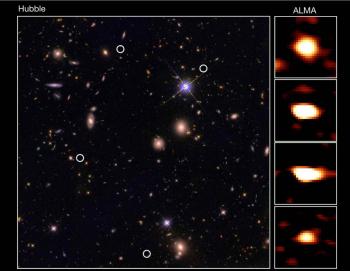A study conducted by astrophysicists of the Department of Astrophysics-AIM Laboratory of CEA-Irfu has revealed a large number of galaxies as massive as the Milky Way in the distant universe, thanks to the large interferometer ALMA (Atacama Large Millimeter/submillimeter Array) in Chile. These galaxies have hitherto remained invisible due to the attenuation of their brightness by interstellar dust. They are 10 to 100 times more numerous than all those detected so far, at distances where the universe was only two billion years old. This great abundance of massive galaxies in the young universe is in contradiction with current theoretical models of galaxy formation and represents a new challenge for our understanding of the early ages of the universe. These results are published in the journal Nature on August 7, 2019.
The content of the young universe.
The distant galaxies are also the youngest, because of the time spent by the light to reach us. But these are the most difficult to observe because, at distances of several billion light-years, their brightness becomes very low. So far, two types of distant galaxies have been discovered: numerous light-weight galaxies detected in the visible light by the Hubble satellite, and a very small number of very particular galaxies observed in the infrared and called "starburst galaxies", because they are real monsters that form stars at a very high rate of 500 solar masses per year, 100 times more than our Galaxie currently.
It is by using the observations made with the large ALMA network, consisting of about 50 antennas detecting light of millimeter wavelength (longer than infrared) and located in the Atacama desert in Chile, that the researchers were able to identify 39 new galaxies hitherto unknown. These are dating back to less than 2 billion years after the Big Bang and represent a new class of young galaxies.

The ALMA network consists of 66 high-precision antennas, operating at wavelengths from 0.32 to 3.6 mm. Its main network includes 50 antennas, each with a diameter of 12 meters, which act together as a single telescope: an interferometer. In addition, there is a compact network of four antennas 12 meters in diameter and 12 antennas 7 meters in diameter. ALMA antennas can be configured in different ways, spacing them from distances of 150 meters to 16 kilometers, resulting in very high spatial resolution images. ALMA credit (ESO / NAOJ / NRAO).
ALMA pierces the dust
To identify these galaxies, the researchers first noticed the existence of medium-infrared light sources appearing in the Spitzer satellite images, located in completely empty areas on the Hubble Space Telescope images. Far-off galaxies suffer from the effects of interstellar darkening of the dust that makes Hubble blind to these galaxies. But, Spitzer's low spatial resolution did not allow to identify the origin of these "spots" of infrared light nor to know with certainty if they came from sources near or far in the universe.
It is the use of the large ALMA interferometer which has finally made it possible to uncover the mystery of the "infrared spots", thanks to the very high spatial resolution images obtained by the interferometry technique. Of 63 sources observed by Spitzer, ALMA detected 39 and confirmed their nature as very distant galaxies, rich in interstellar dust. Interstellar dust is abundant only in the early massive galaxies. It absorbs the UV rays emitted by stars and radiates it back at infrared wavelengths that are further shifted to the millimeter by the expansion of the universe. The search for these galaxies had so far failed because it relied primarily on techniques based on images taken in the visible or near infrared domains, in which these galaxies are totally invisible.

Example of detection of new distant galaxies by ALMA. On the left, the region of the sky observed by the Hubble satellite in the visible domain. The white circles mark the position of the galaxies detected in millimeter radiation by ALMA whose images are shown on the right. These galaxies are totally invisible in the Hubble image. Credit T. Wang / ALMA
These galaxies are the missing link between the populations of galaxies already known at these great distances. They are among the most massive in the universe at this time and ten times more numerous than the most distant galaxies detected so far by the Hubble telescope.
The discovery of these galaxies poses a serious challenge to current models that are unable to explain a star formation efficiency that was able to produce galaxies as massive as the Milky Way in just a billion years. The models that attempt to explain the history of galaxy formation until today are incompatible with such efficiency so soon after the Big Bang. The enigma of these "invisible" galaxies will probably require reviewing the recipes that describe the internal evolution of galaxies, the one that gives birth to stars. A challenge that comes to the point because these "invisible" galaxies should jump to the eyes of the successor of the Hubble telescope, the James Webb Space Telescope whose launch is scheduled for 2021.
Contact : David ELBAZ
Publication :
"A dominant population of optically-invisible massive galaxies in the early Universe"
T. Wang, C. Schreiber, D. Elbaz, Y. Yoshimura1, K. Kohno1, X. Shu6, Y. Yamaguchi1, M. Pannella, M. Franco, J. Huang, C.-F. Lim & W.-H. Wang
published in Nature du 7 aout 2019
See : the CEA press release (7 August 2019)
: the Tokyo University press release (7 August 2019)
See also :
- The distant elliptical galaxies from early universe refuse to form stars (19 January 2018)
- Tracing the Universe: a new X-ray survey bring a new light (4 Octobre 2018)
- Indirect detection of cold gas around distant galaxies in formation (30 August 2017)
Content : D. Elbaz, J.M. Bonnet-Bidaud
• Structure and evolution of the Universe › Evolution of the large structures and galaxies




